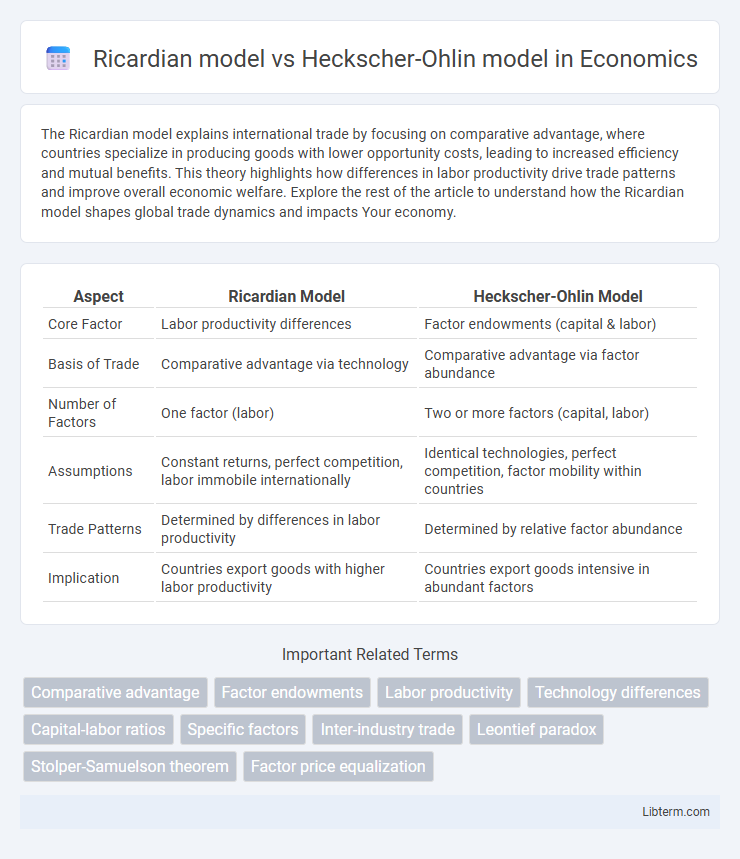The Ricardian model explains international trade by focusing on comparative advantage, where countries specialize in producing goods with lower opportunity costs, leading to increased efficiency and mutual benefits. This theory highlights how differences in labor productivity drive trade patterns and improve overall economic welfare. Explore the rest of the article to understand how the Ricardian model shapes global trade dynamics and impacts Your economy.
Table of Comparison
| Aspect | Ricardian Model | Heckscher-Ohlin Model |
|---|---|---|
| Core Factor | Labor productivity differences | Factor endowments (capital & labor) |
| Basis of Trade | Comparative advantage via technology | Comparative advantage via factor abundance |
| Number of Factors | One factor (labor) | Two or more factors (capital, labor) |
| Assumptions | Constant returns, perfect competition, labor immobile internationally | Identical technologies, perfect competition, factor mobility within countries |
| Trade Patterns | Determined by differences in labor productivity | Determined by relative factor abundance |
| Implication | Countries export goods with higher labor productivity | Countries export goods intensive in abundant factors |
Introduction to International Trade Theories
The Ricardian model emphasizes comparative advantage based on technological differences and labor productivity across countries, explaining trade patterns through opportunity costs. The Heckscher-Ohlin model highlights factor endowments such as labor, capital, and land, predicting that countries export goods intensively using their abundant factors. Both models provide foundational frameworks for understanding international trade but differ in the primary sources of comparative advantage.
Overview of the Ricardian Model
The Ricardian model emphasizes comparative advantage driven by technological differences between countries, highlighting labor productivity as the key factor in international trade. It assumes a single factor of production, labor, and demonstrates that trade benefits arise when countries specialize in goods they produce more efficiently. This model contrasts with the Heckscher-Ohlin model, which focuses on differences in factor endowments, such as labor and capital.
Overview of the Heckscher-Ohlin Model
The Heckscher-Ohlin model explains international trade patterns based on countries' factor endowments, specifically capital and labor. It predicts that nations will export goods that intensively use their abundant factors and import goods that require factors in which they are relatively scarce. This model contrasts with the Ricardian framework by emphasizing multiple production factors rather than solely technological differences.
Key Assumptions of the Ricardian Model
The Ricardian model assumes labor as the sole factor of production and emphasizes technological differences across countries as the basis for comparative advantage. It assumes constant returns to scale and perfect competition in goods and labor markets. Unlike the Heckscher-Ohlin model, it disregards factor endowments such as capital and land, focusing instead on labor productivity variations to explain trade patterns.
Key Assumptions of the Heckscher-Ohlin Model
The Heckscher-Ohlin model assumes two countries, two goods, and two factors of production, typically labor and capital, with countries differing in factor endowments rather than technology. It presumes identical production functions across countries, perfect competition in all markets, and factor mobility within countries but immobility between countries. These assumptions contrast with the Ricardian model, which emphasizes technological differences as the primary driver of comparative advantage.
Comparative Advantage in the Ricardian Model
The Ricardian model explains comparative advantage based on technological differences and productivity variations between countries, where each nation specializes in goods it produces more efficiently relative to others. In contrast, the Heckscher-Ohlin model attributes comparative advantage to factor endowments, such as labor and capital abundance, influencing production costs. The Ricardian model emphasizes opportunity cost and constant returns to scale, providing a clear framework for understanding trade patterns driven by technological disparities.
Factor Endowments in the Heckscher-Ohlin Model
The Heckscher-Ohlin model emphasizes factor endowments, positing that countries export goods that intensively use their abundant factors of production, such as labor, capital, or land. Unlike the Ricardian model, which attributes comparative advantage to technological differences, the Heckscher-Ohlin theory explains trade patterns based on variations in resource availability and factor proportions. This model predicts that a capital-rich country will specialize in capital-intensive goods, while a labor-abundant country focuses on labor-intensive products, driving international trade dynamics.
Real-World Applications and Implications
The Ricardian model emphasizes comparative advantage based on labor productivity differences, making it particularly useful for analyzing trade patterns between countries with varying technological levels. The Heckscher-Ohlin model highlights factor endowments like capital and labor, explaining real-world trade flows driven by resource abundance. Policymakers apply these models to design trade agreements and predict impacts on income distribution, employment, and industrial competitiveness in diverse economies.
Major Differences Between Ricardian and Heckscher-Ohlin Models
The Ricardian model emphasizes comparative advantage driven by technology differences between countries, resulting in trade based on productivity variations in a single factor of production--labor. The Heckscher-Ohlin model focuses on factor endowments, explaining trade patterns based on differences in countries' relative abundance of capital and labor, predicting specialization according to factor intensity. While Ricardian theory highlights technology as the primary cause of comparative advantage, Heckscher-Ohlin theory attributes it to relative factor proportions, offering a more complex explanation involving multiple production factors.
Conclusion: Evaluating Trade Theories in Practice
The Ricardian model emphasizes comparative advantage driven by technological differences, while the Heckscher-Ohlin model highlights factor endowments such as labor and capital as the basis for trade. Empirical evidence shows that countries often engage in trade patterns explained by both models, with technology and factor proportions influencing comparative advantages simultaneously. Policymakers must consider the complementary insights of these theories to better predict trade flows and design effective trade policies.
Ricardian model Infographic

 libterm.com
libterm.com